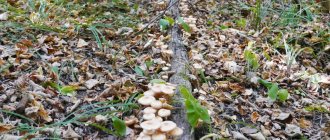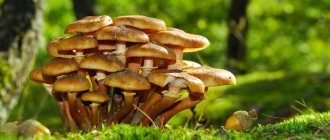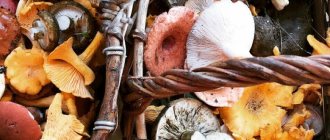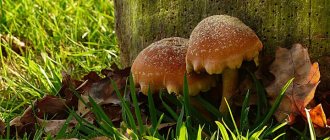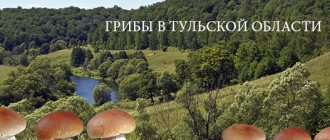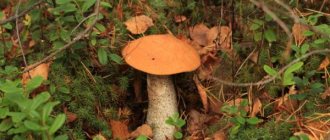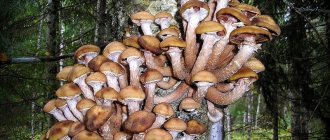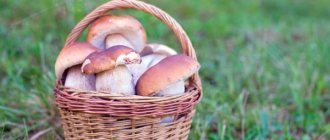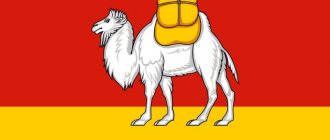Unlike other regions of Russia, the Rostov region cannot boast of an abundance of mushroom places. Poorly fertile soil, combined with an arid climate from spring to autumn, allows only experienced mushroom pickers and resourceful beginners who have learned the secrets of collecting in advance to collect conditionally and edible mushrooms. The rest have to rely solely on luck and luck.
On city forums and social networks, you can already see reviews indicating the start of collection. Photos of the trophies have already caused controversy among local residents. The limited number of fertile places leads to disagreements. Some claim that they find mushrooms in sufficient quantities not only for frying, but also for preparations for the winter. Others claim that there is no smell of the forest’s gifts. It’s hard to say who to believe. It’s better to see for yourself by going to the 2022 mushroom camp by minibus or car, armed with everything you need.
What mushrooms grow in the Rostov region and how to find them?
2022, like the past few years, does not stand out for its abundance. The peculiarities of the climate limit quiet hunting, allowing only mushroom pickers to collect full baskets, who go hunting only after heavy rains, and who carry a map of mushroom places, the necessary equipment and a navigator that tells them the way back.
Mushrooms of the Rostov region 2022 - not limited to varieties. If desired, you can collect not only conventional and edible mushrooms for food, but also inedible ones, which are popular in folk medicine. Based on their pulp and decoction, alcohol tinctures are prepared for rubbing and compresses that relieve inflammation and pain from bruises, chronic diseases and other ailments.
For preparing all kinds of dishes, canning, pickling, drying and freezing, local residents choose famous mushrooms, known for their high taste and subtle mushroom aroma. Among the popular ones are: oyster mushrooms, Judas ears, morels, porcini mushrooms and obabkas, boletus and saffron milk caps, bluelegs, chanterelles and champignons, greenfinches and frammulines. Each subspecies can be collected in small quantities even in dry places with soil unfavorable for germination. Assorted mushrooms are well suited for drying or storing for the winter, having a short shelf life.
Compared to last year, 2022 did not bring many mushrooms to the residents of Rostov. Studying the reviews left by mushroom pickers on forums and photographs shown on social networks, one can assume that even autumn, the peak season starting in September, is unlikely to change the current situation.
However, anyone who still wants to replenish their pantry with supplies by trying their luck in the thicket should carefully read the description of the most popular mushrooms that sprout at different times of the year. Some bear fruit exclusively in spring, others - in summer, others - in autumn, and others - can germinate several times throughout the year, allowing mushroom pickers to take breaks between harvests.
TOP 10 edible and conditionally edible mushrooms
No. 1 - porcini mushroom (boletus)
The most delicious and valuable edible mushrooms remain boletus mushrooms, which grow in deciduous and mixed forests. You can see the fruits from the end of August until the first frost. Depending on the variety, they skillfully camouflage themselves with the surrounding nature thanks to their cap, which has a different shade of brown.
No. 2 - bluelegs
One of the favorite mushrooms among connoisseurs remains bluelegs or, as they are also called, lilac-legged rowers. A special feature of this breed is its purple color, which completely colors the stem of the edible fruit. During initial boiling, the pulp of the fruit can color the water blue and purple, thereby frightening beginners who decide to stock up for the winter.
No. 3 and 4 - morels and lines
The first mushrooms to sprout in the spring months remain popular only among experienced mushroom pickers who are aware of their existence. Their unusual shape, reminiscent of coral or brains, when cooked has a pleasant aroma, high taste with notes of sweetness, slightly similar to chicken chops.
It is not recommended to collect lines in the last few years. Due to the subspecies included in the category of “poisonous”, beginners, out of ignorance, can confuse them by collecting fruits with a high content of poison in their baskets. Therefore, in order not to risk your health and the condition of your family and friends, you should choose morels over the lines.
No. 5 - boletus and boletus
Obabkas have remained one of the most delicious gifts of the forest for many years. Based on the name, it is not difficult to guess that mushrooms can be found near aspen and birch trees that grow in the forest belt.
There is a greater chance of finding noble mushrooms among young plantings.
No. 6 - butter
A distinctive feature of these edible mushrooms is their wet and slightly sticky cap, which dries out only during dry periods. You can meet boletus not only in autumn, but also in spring, when competition, unbeknownst to many, is reduced several times.
The sweetish pulp of the mushroom is liked not only by people, but also by worms that infect the pulp during long-term growth. Therefore, if along the road there are only wormy fruits, it is worth cutting off only the small, recently born ones. This approach will reduce the percentage of spoiled products, allowing you to harvest more of the noble harvest.
No. 7 - chanterelles
Bright mushrooms with a delicate structure and high value, well suited for preparing various dishes. Their collection is limited only to the summer period. It is not difficult to meet families of edible chanterelles when going into the forest after heavy rain.
A distinctive feature of edible and poisonous chanterelles is their color. Noble mushrooms are colored yellow, and false mushrooms are orange.
No. 8 - champignons
Like previous mushrooms, they are valued among residents of the Rostov region. However, it is recommended to collect them only for experienced mushroom pickers who can distinguish edible subspecies from poisonous ones that can cause irreparable harm to human health.
The fruiting period falls in summer and early autumn.
No. 9 - saffron milk caps
On the coniferous litter you can find not only snotty butterflies, but also delicious saffron milk caps. Their growth occurs in mid-summer and ends only at the end of October, when the air temperature drops to the minimum value for mycelium germination.
No. 10 - greenfinches
Despite the prohibitions of many experts, mushroom pickers continue to collect greenberries without worrying about their health. Their taste and texture when preserved are reminiscent of barrel cucumbers and milk mushrooms.
Helpful information!
When collecting at different times of the year, you should know that summer mushrooms of the Rostov region 2022 are suitable for preparing snacks and pates, first and second courses, and preparations for the winter. Autumn and spring breeds are used exclusively for drying, freezing and preparing marinade.
Names of edible species, description and where they grow
Picking mushrooms is a very responsible activity. In Rostov forests there is a fairly wide variety of species of mushrooms , of which only a few dozen are classified as edible.
However, the Rostov region is not traditionally considered a mushroom region, and in order not to endanger your health and life, you need to know what mushrooms can be collected, as well as their name and basic description. The first edible mushrooms grow in the spring, and they can be collected as early as May, but such spring mushrooms are less tasty and valuable than summer and autumn species.
| Species name | Description of the fruiting body | Fruiting dates |
| Bebik or porcini mushroom | The cap is often convex, from red-brown to almost white, darkening with age. The leg is massive, maybe with a mesh pattern. The tubular layer is often white | Mass collection begins in the second half of August |
| Obabok or boletus | Most often has an orangish-red cap, a thick and “stocky” leg, a whitish-gray tubular layer | From mid-June to late September |
| Ryadovka lilac-legged or “blue leg” | The cap is convex, but flattens with age, the stem is purple in color, the plates are frequent | The active fruiting season is in the autumn |
| Oil can | The cap is convex or flattened, the leg is solid, with a smooth or granular surface | From mid-June to significant cooling in autumn |
| Chanterelle | Light orange or orange-yellow colored cap and leg are combined into a single whole, without a pronounced and clear transition | The first ten days of June, and then from August to October |
| Morel | Fruit body with a high level of porosity, hollow inside. The main color of the cap surface is brownish. | Spring period, after the snow melts and the soil warms up |
| Winter honey fungus or Flammulina velvety-footed | Cap mushroom with a honey-brown or orange-brown cap and a tubular, dense stalk | Fruiting during winter thaws |
| Real saffron milk cap | The color of the cap can vary from a yellowish-ochre color to a dark brownish-orange hue. The leg may be pubescent. | Mass fruiting occurs from the end of July to the end of August, as well as at the beginning of September |
| Champignon | A massive and dense cap with a smooth surface, the color of which can vary from whitish to brownish-brown. The leg is smooth, may be loose or hollow | From summer until the onset of autumn cooling |
Inedible, hallucinogenic and poisonous mushrooms - TOP 5
Comparing the germination of edible fruits with those unsuitable for consumption, it can be noted that there are many times more of the latter in the Rostov region. It’s not difficult to come across them, but collecting them in a basket is not a problem at all. To avoid such trouble and protect your health, you should know the enemy by sight.
Below is the TOP 5 most common mushrooms for 2022 that can harm human health.
No. 1 - red fly agaric
Even children know that mushrooms with red caps cannot be picked. Therefore, regardless of whether there are white spots on the red or not, you should avoid such “gifts”.
It is not uncommon for mushroom pickers to confuse red fly agaric with edible mushrooms due to the pattern being washed away after heavy rains.
No. 2 - soap row
The gray, repulsive color, combined with a sharp, specific smell, is a warning to the collector about the content of poisons in the tricholoma pulp. Soap bark, although similar to edible subspecies, can cause severe poisoning of the body, leading to intoxication and failure of vital organs.
No. 3 - pale grebe
In order not to collect a small but very dangerous mushroom in your basket, you should carefully look at the prey. If, by chance, the toadstool does end up with edible mushrooms, the harvested crop should be completely discarded. A large amount of poison can be transferred to nearby mushrooms, remaining in the pulp even after heat treatment.
Don't take risks!
No. 4 - royal fly agaric
This fly agaric has become famous not only for its poison content, but also for its relationship to hallucinogenic mushrooms. The appearance of this mushroom is difficult to confuse even with umbrellas growing in any forests or open areas.
No. 5 - false honey mushrooms
Today there are many varieties of honey mushrooms. And in order not to confuse edible species with poisonous ones, you should carefully familiarize yourself with the distinctive features. Caution will protect you from poisoning, allowing you to harvest without worries not only for food, but also for preparations for the winter.
Collection rules
The main period for the appearance of edible mushrooms is in early summer and autumn. It is important to remember that in particularly hot weather the larvae multiply quickly, which means the quality of the mushrooms will be low.
To go out into the wild, you need to prepare clothes that are appropriate for the temperature and protect against insects that are active this season.
To avoid insect bites, some mushroom pickers put on gardening gloves and go out “hunting” in the morning.
Collection points should be located away from roads and populated areas.
- It is advisable to have an illustrated reference book with you for a detailed comparison of fruiting bodies, paying special attention to the color change when broken, their smell and structure.
- You cannot pick specimens that are too young; they do not have all the characteristics that allow them to be unmistakably recognized. Fly agarics are often similar in appearance to sandpipers.
- To prevent the mycelium from drying out and bearing fruit in the future, after cutting, you need to carefully sprinkle the cut areas with earth. The collected product is processed during the first day, boiling for at least 20 minutes.
- Only familiar cap mushrooms that are beyond doubt of their edibility are collected; drying is allowed only for edible, non-worm-free mushrooms.
- Summer can be especially dangerous - poisonous steppe snakes appear during the dry season, so it is undesirable to go out in hot weather.
Precautionary measures
Mushroom pickers advise putting the caps in a ventilated container - a long absence of air and warming up can activate the synthesis of toxic substances that are not destroyed even during heat treatment.
It is better to refuse a plastic bag; a humid environment creates excellent conditions for the growth of mold, as well as pathogenic microorganisms and bacteria that are dangerous to health.
Fresh material requires immediate preparation.
Before cooking, you need to thoroughly clean the caps from soil and dust, soaking them in water for 10-15 minutes, then carefully remove the film or use a sponge to clean vegetables. In some cases, you can use a knife (cutting damaged areas, tips of legs, etc.)
Once boiled, they can be frozen, and the dried mass can be used to prepare aromatic mushroom seasonings for main dishes.
The most mushroom places in the Rostov region + map
In 2022, as in the past, lovers of quiet hunting highlight six places that allow them to reap a good harvest. Mushroom pickers highlight:
- Shchepkinsky forest and its surrounding areas;
- A forest clearing passing near the Don River;
- Chertkovsky district;
- territory of Semikarakorsky district;
- Tarasovsky district and the area around it;
- pine trees growing in the Millerovsky district.
In order not to harm your health, you should worry about safety. When going to the forest, you should take with you the necessary equipment, dress for the weather, covering your legs, arms and head from attacks by ticks and poisonous snakes.
Photo map of mushroom places
Useful tips
When going into the forest, every mushroom picker should remember safety and life hacks that allow you to collect the maximum harvest without harm to your health.
- First recommendation
As in previous years, mushrooms in the Rostov region 2022 should be collected only at a young age. Excessive levels of radiation and unfavorable climate can affect the content of poisons and carcinogens in the product.
- Second recommendation
You should go on a quiet hunt on weekdays from Wednesday to Friday. At the height of the work week, competition is reduced, and the fruits have time to grow after the weekend.
- Third recommendation
You should not collect mushrooms with a repulsive aroma or fruits infected with worms.
- Fourth recommendation
Before heading into the forest, you should study a map of mushroom places by drawing up a route on a GPS navigator.
- Fifth recommendation
When hunting, you need to dress properly, not forgetting to take useful equipment with you.
Harvest photo:
Mushrooms in 2022 in the Rostov region, despite the limited quantity, can be collected by going in search of one of the mushroom places. However, you should not risk your health by collecting fruits that are questionable.
Let's sum it up
The mushroom places of the Rostov region are very extensive. With the arrival of the quiet hunting season in 2019, you can go in search of mushrooms in a proven forest area.
An attentive mushroom picker makes a good collection in the shady root areas of birch, hornbeam, oak and coniferous trees.
There is a lower chance of encountering harmful specimens in the fall, when myceliums bear fruit en masse under the influence of rainy weather.
It is advisable for beginners to go hiking with experienced people who know the names and descriptions of most mushrooms.
